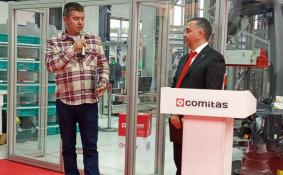Scientific & Practical Journal

Editorial News
Dear readers! We are pleased to present to you the eleventh issue of the journal in 2025. There are a lot of relevant and useful materials in the issue, which, hopefully, will not be ignored.
Dear readers! In September the CeMAT RUSSIA exhibition was held, which showed everyone that innovations and robotics are increasingly penetrating the logistics industry. We can safely say that many technologies are tested here, and only then they go out into the world. However, it is not only CeMAT RUSSIA that demonstrates the prevalence of the digital agenda.
Dear readers! This is the ninth issue of the journal, which turned out to be very rich and diverse. Traditionally, the issue is opened by an analyst. The material by Alina Nasyrova from the Market Guide Agency, dedicated to investments in warehouse complexes in Russia, recalls the importance of developing logistics infrastructure for the integrated development of regions.
PHOTO OF THE WEEK
CITATIONS
All News of Logistics
Volvo Trucks launches new generation of heavy-duty trucks with the driver in focus
Volvo Trucks is introducing four new trucks, with a strong focus on the driver environment, safety and productivity. “We are really proud of this big forward-looking investment. Our aim is to be our customers’ best business partner by making them even more competitive and help them attract the best drivers in an increasingly tough market,” says Roger Alm, President Volvo Trucks. The four heavy-duty trucks; Volvo FH, FH16, FM and FMX, represent about two thirds of Volvo Trucks’ deliveries.
An expected growing demand for transport is putting pressure on the availability of skilled drivers worldwide. In Europe, for example, estimates show that around 20 percent of all driver jobs are vacant. To help customers recruit and retain the best drivers, Volvo Trucks has focused strongly on developing the new trucks to make them safer, more efficient and more attractive working tools for qualified drivers.
“Drivers who handle their truck safely and efficiently are an invaluable asset to any transport company. Responsible driving behaviour can help reduce CO2 emissions and fuel costs, as well as helping reduce the risk of accidents, injury and unplanned downtime. Our new trucks will help drivers work even more safely and productively and give our customers stronger arguments when competing to attract the best drivers,” continues Roger Alm.
The various truck models in Volvo Trucks' range are available with many different cab models and can be optimised for a wide range of applications. In long-haul trucks, the cab is often the driver's second home. In regional transport trucks it often serves as a mobile office, while in construction the trucks are robust, practical work tools. Therefore, visibility, comfort, ergonomics, noise level, manoeuvrability and safety were key focal points when developing all the new truck models. The truck exterior has also been upgraded to reflect the new trucks' properties and create an attractive overall design.
New cab, offering more space and improved visibility – Volvo FM and Volvo FMX The new Volvo FM and Volvo FMX have a brand new cab, as well as many of the same instrument display functions as their larger Volvo counterparts. Their interior volume has been increased by up to one cubic meter, providing better comfort and more working room. The visibility is now even better due to larger windows, a lowered door line and new mirrors.
Efficient engines and alternative drivelines Both the environment and economics are important factors for haulage companies. As there will not be one singular energy source that addresses all climate change issues, and since different transport segments and assignments will require a variety of solutions, several types of drivelines will continue to exist in parallel for the foreseeable future.
In many markets, the Volvo FH and Volvo FM are available with the Euro 6 compliant gas-powered LNG engine that offers fuel efficiency and performance on par with that of Volvo’s equivalent diesel trucks, but with a far lower climate impact. The gas engine can run on either biogas, which cuts CO2 by up to 100 percent, or natural gas which reduces CO2 emissions by up to 20 percent when compared with Volvo’s equivalent diesel trucks. This relates to emissions from the vehicle during usage, known as tank to wheel.












